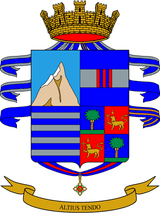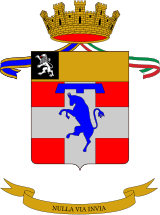1st Alpine Division Taurinense
The 1st Alpine Division Taurinense was a World War II light Infantry division of the Italian Army which specialised in Mountain Combat. The Alpini that formed the divisions are a highly decorated and elite mountain corps of the Italian Army consisting of both infantry and artillery units. Today, the traditions and name of the 1st Alpine Division Taurinense are carried on by the Alpine Brigade Taurinense.
| 1st Alpine Division Taurinense | |
|---|---|
 Coat of Arms of the 1st Alpine Division Taurinense | |
| Active | September 10, 1935 – September 10, 1943 |
| Country | Italy |
| Branch | Regio Esercito |
| Type | Alpini |
| Role | Mountain Infantry |
| Size | 17,460 men |
| Garrison/HQ | Turin |
| Engagements | World War II |
| Commanders | |
| Notable commanders | Carlo Vecchiarelli, Luigi Nuvoloni, Paolo Micheletti, Paolo Puntoni, Giovanni Maccario and Lorenzo Vivalda |
Formation
The Taurinense division was constituted on 10 September 1935 through the reorganization of the existing 1st Superior Alpini Command. The headquarters of the division was in the city of Turin and the majority of its soldiers were drafted from the surrounding valleys—hence the name "Taurinense", from the Roman name of the city of Turin Augusta Taurinorum.
Order of battle









- Susa artillery group
- Aosta artillery group

- 305th Medical Section
- 130th Motor Transport Section
- 60th Supply Section
Ethiopia
When Italy decided to invade Ethiopia in 1935, the Exilles and Intra battalions and two artillery batteries from each of the divisions were attached to the 5 Alpine Division Pusteria and sent to Eritrea. The detached units returned to the Taurinense after the Pusteria's return to Italy in 1937.
France
From 10 June to 24 June 1940 the division advanced with other Italian units into Southern France and occupied Bourg-Saint-Maurice, where it was garrisoned after the end of hostilities. It remained in France until January 1942.
Yugoslavia
The division was then sent to Mostar in the Independent State of Croatia to take part in anti-partisan operations during World War II in Yugoslavia. After arriving in Mostar, the division was placed under the command of the Italian XIV Army Corps and participated in the third Axis anti-Partisan offensive. The division captured Trnovo, and also reached and blocked Kalinovik where it made contact with elements of the 22 Infantry Division Cacciatori delle Alpi; but, overall, the offensive was a failure.
In August 1942 the division was sent to Montenegro. A year later the division took part in the fifth Axis anti-Partisan offensive, but did not complete its objectives there either. After the signing of the armistice between Italy and the Allied armed forces on 3 September 1943 and after the German invasion of Italy on 8 September, the division dislocated around the Bay of Kotor surrendered to German forces and was subsequently dissolved. However, some of its units (mainly the Ivrea battalion and Aosta artillery group) refused to surrender and with other Italian units stationed in the Balkans formed the Italian Partisan Division Garibaldi—fighting now under command of the II Yugoslav partisan Corps against the German Forces.